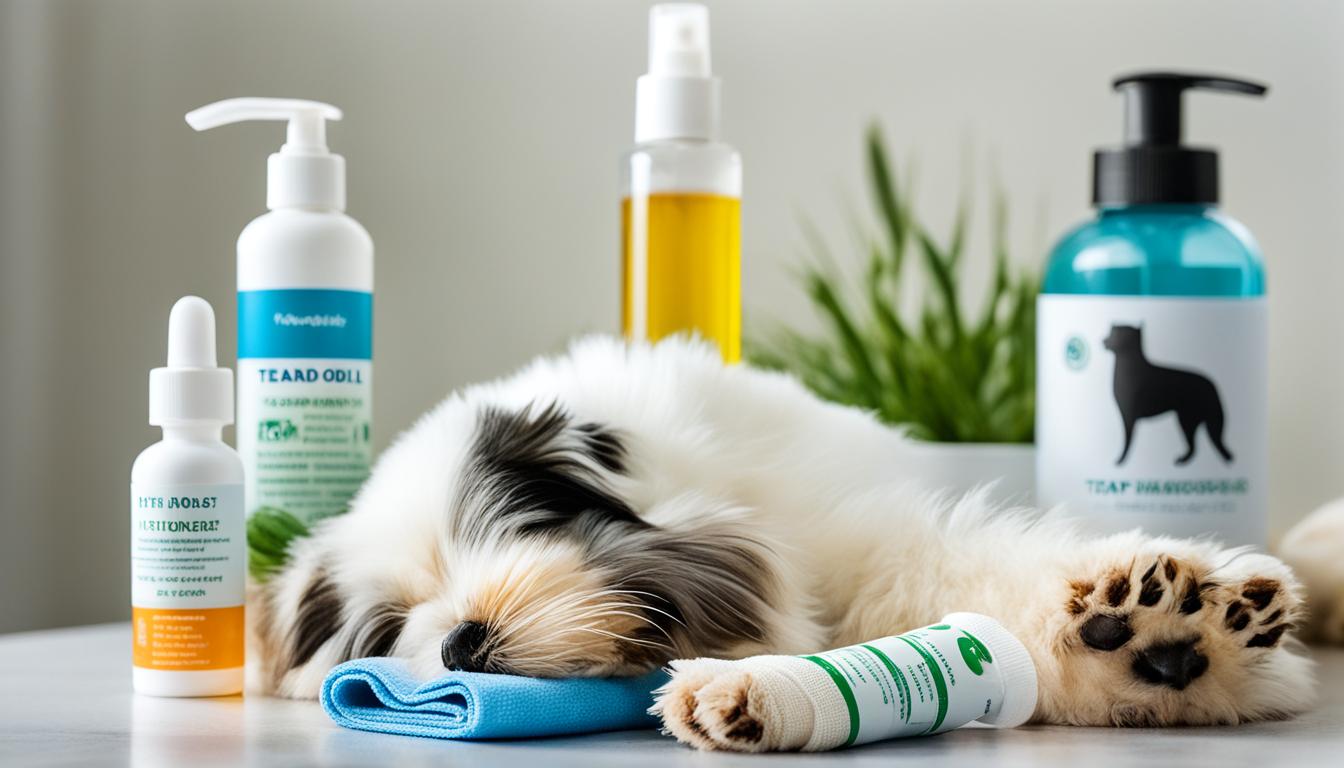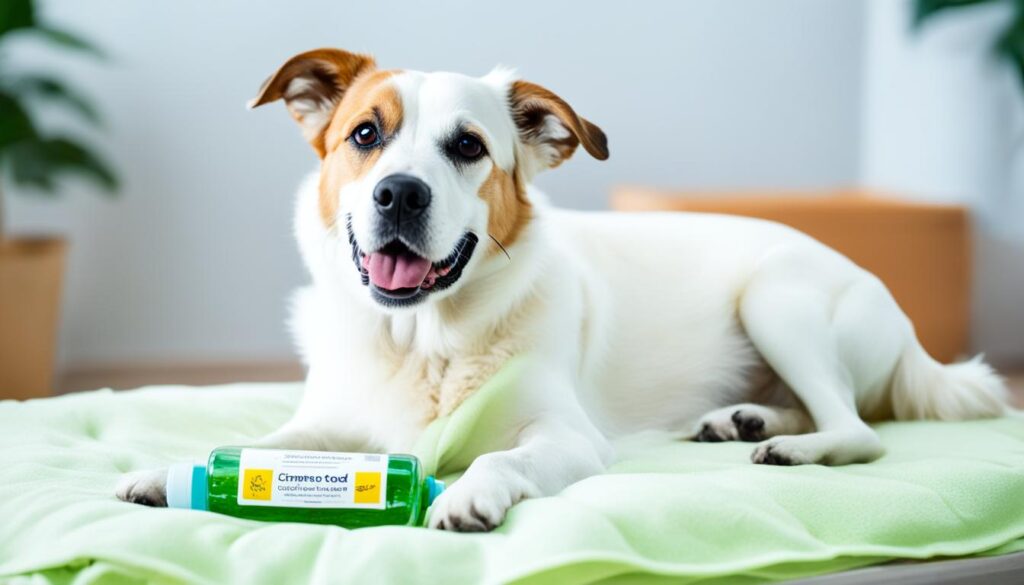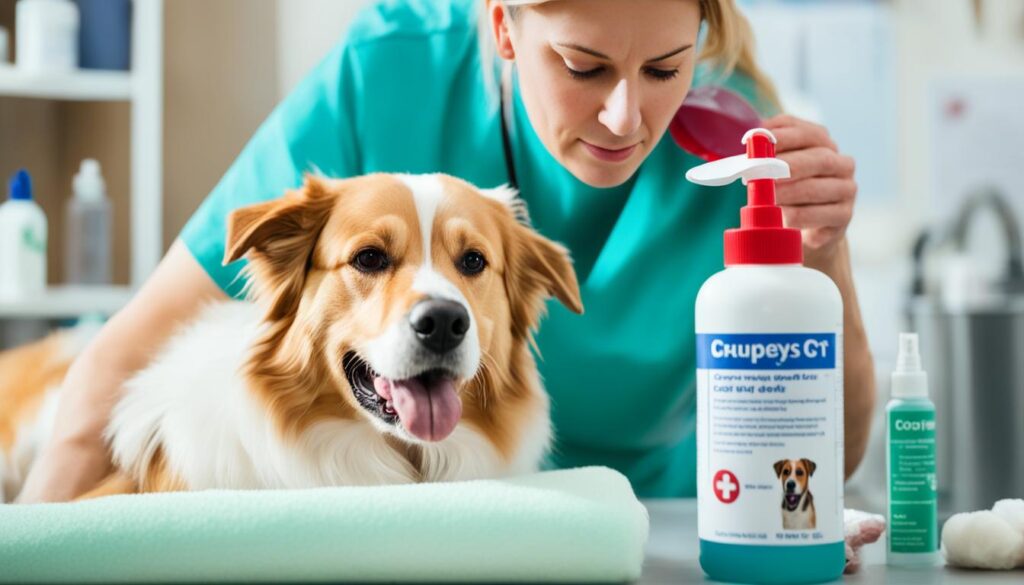Have you ever seen a lump on your dog that starts leaking a strange fluid? This can happen when a sebaceous cyst pops open. Many dog owners get worried when this happens. It’s important to know what to do to help your dog feel better and stay healthy. Some dogs, like Boxers, Shih Tzus, and Schnauzers, might get these cysts more often. So, if you have one of these breeds, it’s good to be ready for this situation1
These cysts can be small or big, ranging from one-quarter to two inches wide1. When they burst, they let out a light grey or white liquid1. Right away, you should check the wound, clean it, and think about when to call the vet. You can do simple things like using a warm cloth or special cleaning solution. But, sometimes, the vet might need to do more, like surgery.
Key Takeaways
- Sebaceous cysts are common in dogs, especially in certain breeds1.
- Ruptured cysts can discharge fluid and require prompt cleaning and assessment1.
- Immediate home care includes wound cleaning and knowing when to contact a veterinarian.
- Treatment options range from home remedies to surgical interventions as needed.
Understanding Ruptured Cysts in Dogs
Sebaceous cysts are common in dogs, appearing as lumps filled with fluid or waxy stuff. They show up anywhere on a dog, especially in certain breeds. Boxers, Shih Tzus, Schnauzers, and Basset Hounds are more likely to get them1. When these cysts break open, knowing why and what to look for is key to help your dog heal.
What are Sebaceous Cysts?
These cysts start in the sebaceous glands and are like small sacs1. They can be as tiny as a quarter inch or as big as two inches1. Older dogs, especially those breeds we mentioned before, can have these more often because of their genes2. To find out what a bump is, a vet might do a FNA test or suggest a biopsy if they’re not sure1.
Causes of Cyst Ruptures in Dogs
Many things can make sebaceous cysts break open. Blockages, injury, sun damage, and infections are top reasons. Dogs without much hair, like the Chinese Crested, can get lots of cysts because their hair doesn’t grow1. Cysts from injuries are also quite usual2. Knowing these causes helps you take care of your dog after their cyst bursts.
Common Symptoms of Ruptured Cysts
It’s important to spot signs of ruptured cysts for good aftercare. Look out for raised lumps with a whitish or light grey discharge. The skin may be red, swollen, or smell bad if it’s infected. Keep an eye on any lumps, especially if your dog is in a high-risk breed, like Boxers or Shih Tzus2. Early recognition is vital when treating your dog’s ruptured cysts at home.
Initial Steps to Take When a Cyst Ruptures
Having a dog with a ruptured cyst is worrying for owners. Knowing what to do first is key. It ensures the dog gets better quickly.
Assessing the Cyst
Start by looking at the cyst carefully. Notice its size, where it is, and if it’s leaking. Most dog skin issues fall between a fraction of an inch to two inches1. Watch for any signs the cyst is infected, like it’s red, swollen, or smells bad. Some breeds, such as Boxers, Shih Tzus, and Schnauzers, are more likely to get these cysts because of genes1.
Cleaning the Wound
Then, make sure to clean the area. Use special cleaning stuff for wounds. This helps stop more germs from getting in. Also, it helps the wound heal faster. Keep checking the wound to make sure it’s staying clean.
When to Contact Your Veterinarian
If the wound is leaking a lot, bleeding, or the dog is in pain, call the vet. It’s especially urgent if the dog keeps bothering that spot. This can be a sign of added discomfort or an infection. Even if a home remedy sounds good, seeing the vet is crucial. They make sure the dog gets the right care1.
Home Remedies for Ruptured Cysts in Dogs
At-home care for ruptured cysts is key for healing and comfort. Using warm compresses, antiseptic solutions, and easing your dog’s pain is very helpful.
Warm Compress Application
Applying a warm compress helps with drainage and healing. It cuts down on swelling and boosts blood flow, aiding in healing. Doing this often makes your dog feel better and helps them heal quicker.
Using Antiseptic Solutions
Keeping the wound clean is essential to avoid infection. Using antiseptic solutions like iodine or chlorhexidine is advised. It helps remove harmful substances, lowering the risk of problems.
Pain Management and Comforting Your Dog
Making sure your dog is comfortable is very important while healing. Using pain relief and having a cozy bed helps. Also, keep the environment stress-free for better recovery.
Following these steps for caring for ruptured cysts helps your dog a lot. It makes healing at home better and not hard for you or your pet. Older dogs and some breeds are more likely to get these cysts13. Breeds like Boxers, Shih Tzus, and Schnauzers are at higher risk because of their genes1. Good home care helps keep complications away. Timely care is important to manage these cysts well.
Preventing Infection in Ruptured Cysts
It’s key to stop infections in ruptured cysts to keep your dog healthy and help them heal fast. To avoid infection, keep the area clean and dry. This means regular cleaning and changing bandages really matter.
Maintaining a Clean Environment
Keeping things clean is vital for taking care of ruptured cysts in dogs. You need to clean not just the wound but also around it to prevent bacteria from causing harm1. Cysts, especially ones near glands, or sebaceous cysts can break open. If not cleaned well, they can get infected23. Cleaning often and using the right wound care is key when looking after ruptured cysts at home. Sebaceous cysts are especially at risk because they can pop up anywhere on your dog, usually on their head, neck, and chest1.
Signs of Infection to Watch For
Knowing the signs of infection early is crucial. Look out for more redness, swelling, or a bad smell from the cyst. These signs mean there might be an infection needing a vet’s help right away. Sebaceous cysts happen when hair follicles are blocked. This makes them fill with sebum and maybe get infected if not treated3. Some dogs, like Boxers, Shih Tzus, and Schnauzers, are more likely to get cysts over and over. This makes spotting infections early super important21.
Getting help early, either with antibiotics or from a vet, is important for managing ruptured cysts in dogs. Keep an eye on your dog and their environment to make sure their care goes well1.
Home Care for Ruptured Cysts in Dogs
It’s very important to care for your dog’s ruptured cysts at home. This helps them heal faster and feel less pain. Sebaceous cysts are often found in dogs, such as Boxers, Shih Tzus, and Schnauzers1. They range in size from tiny to about two inches wide1. Your dog might have one or many of these cysts on its skin1. Owners can do certain things to help their pets with first aid for these cysts and ongoing care.
First, look at the cyst once you see it’s opened. These cysts usually show up on the head, neck, chest, or legs1. You must clean the area well to avoid infections. Using a mild antiseptic can keep it clean and help it heal.
Next, use a warm, wet cloth on the cyst area. This can make your dog feel better and help the fluid drain out. Dogs without much hair, like the Chinese Crested and Xoloitzcuintli, may get these cysts more often. So, it’s important to check them often1.
It’s also key to keep your dog calm and quiet. This prevents them from making the injury worse. Watch for signs like a lot of blood, a bad smell from the wound, or a very red area. If you see these signs, call the vet right away.
Following these steps can really help with your dog’s ruptured cyst. Make sure to do these things carefully. If your dog doesn’t get better, see the vet to help them feel well again.
Caring for Post-Rupture Wounds
Taking care of post-rupture wounds is key to helping a dog heal well. After surgery, it’s vital to keep the wound clean and watch it closely. There are a few important steps dog parents should take carefully.
- Clean the area with vet-approved solutions to stop infections and help it heal faster.
- Check the wound often for any signs of infection, like redness or swelling. If you see these, get help from a vet fast3.
- Stop the dog from bothering the area by using a special collar if necessary1.
The aim of caring for ruptured cysts is to avoid troubles in the healing process. Good care lowers the chance of infection. This means your pet can recover more easily3.
Common Mistakes to Avoid in Home Care
Looking after a Dog Cyst Rupture at home needs attention to details. Many people make a mistake by using human meds for their dogs. But, human meds might not be safe and can cause bad effects.
Over-the-Counter Medications to Avoid
Don’t use over-the-counter meds for dogs without talking to a vet. Wrong meds could make your dog very sick. Stick to what your vet suggests. Human first aid creams and pain meds can harm dogs. Drugs like ibuprofen and acetaminophen are dangerous too. They often harm pets.
For managing Dog Cyst Rupture, only use what the vet says4. Always talk to your vet before giving any new treatment. This avoids problems.
Proper Bandaging Techniques
Using the right bandaging method is key for Dog Cyst Rupture care. A too tight bandage can hurt your pet. An air-tight wrap or one that’s too loose can cause problems. Make the wrap snug but not squeezing the skin. This way, your pet stays comfy and heals well.
Here’s how to bandage correctly:
- Use a saline solution to clean the wound4.
- If the vet says, add antibiotic cream4.
- Put a clean gauze over it and wrap it gently with a bandage.
- Change the bandage often to keep the wound clean and avoid infection.
Doing this right supports healing and manages cysts well. If you’re not sure about something, ask a vet. They’re the best help for your dog.
When Professional Treatment is Necessary
Some dogs can deal with sebaceous cysts at home. But sometimes, experts have to help out. This is especially needed if the cysts keep coming back, pointing to a bigger health issue. Then, it’s time for a thorough check-up.
Persistent or Recurrent Cysts
Some dog breeds like Boxers, Shih Tzus, and Basset Hounds often get sebaceous cysts1. If you see these cysts keep coming back or are very painful, get help. The vet might do some tests to find out what’s causing all this. It could be from injury, sun damage, or infection1.
Surgical Options for Cyst Removal
If cysts keep coming back or are hard to handle, surgery might be the best answer. This can stop new cysts from growing and make your dog feel better. The type of surgery might be regular or laser, especially for sweat gland cysts2.
After surgery, your dog needs special care to heal. Clean the area often and watch for any infections. Your vet might also give you antibiotics for your dog3. With the right help, your dog can get better for the long term.
Tips for Preventing Future Cysts
Help your dog avoid cysts by keeping them clean and watching what they eat. Grooming regularly stops cysts from forming because it keeps the skin healthy2. Make sure your dog’s skin looks good and stays smooth.
Regular Grooming and Skin Care
Brushing your dog often is key to stop cysts. This keeps their skin free from problems like follicular or sebaceous cysts2. If not treated, these can lead to infections. Also, keeping the skin clean helps avoid blockages that cause false cysts.
Dietary Considerations
What your dog eats is also important. A diet with enough essential fatty acids is good for their skin. This diet can stop cysts from happening. Breeds like the Chinese Shar-Pei and Boxers, who often get interdigital cysts, need special food5. This can include avoiding foods that cause allergies and keeping the right weight.
So, by brushing often and watching their food, you can help your dog stay healthy. Also, make sure they don’t get hurt from too much pressure or from the sun. A clean, healthy home is good for your furry friend’s overall health.
Conclusion
Dealing with a dog’s ruptured cysts is about knowing the basics of these common issues. Mainly, these are sebaceous cysts from oil glands1. These bumps can be from 1/4 to 2 inches wide. By using warm compresses and cleaning carefully, dogs can heal well.
The first step is to check the cyst’s size and where it is. You want to be sure to clean it well to avoid infections. It’s important to keep your dog calm and to help them feel less pain. Things like trauma, too much sun, and genetics can lead to cysts in dogs like Boxers, Shih Tzus, and Basset Hounds16.
If the cyst looks bad, or the dog is in lots of pain, see a vet. They may need to do tests or even surgery. Following vet advice helps dog owners take good care of their pets. This ensures their dogs get better and stay healthy.
FAQ
What are Sebaceous Cysts?
Sebaceous cysts are small bumps that may have fluid or waxy stuff inside. They come from oil glands. Dogs like Boxers and Shih Tzus can get these, especially when older.
What causes cyst ruptures in dogs?
Cysts can break open because of blocked pores or damage from injuries. Sunny days can also be a trigger. If they get infected, they may burst.
What are the common symptoms of ruptured cysts?
You might see a bump and some white or grey stuff coming out. The area could be red and sore, especially if it’s infected.
What are the initial steps to take when a cyst ruptures?
First, check the wound and clean it. Use something safe to kill germs. Watch for more problems and call the vet if things look bad.
How can I apply a warm compress to a ruptured cyst?
Soak a cloth in warm water and put it on the cyst gently. This should be done for a short time to help it heal.
What antiseptic solutions can be used on a ruptured cyst?
It’s best to clean it with stuff like betadine or chlorhexidine. These can keep it from getting worse and help it heal.
How can I manage pain and comfort my dog with a ruptured cyst?
Make sure to use medicine that your vet says is okay. Keep your dog calm and comfy. Warm pads can also relieve pain.
How do I prevent infection in a ruptured cyst?
Cleanliness is crucial. Use antiseptic solutions and change bandages often. Look out for bad signs like more pain or smell.
What are the signs of infection in a ruptured cyst?
Warning signs are more redness, swelling, more discharge, or a bad smell. If you see these, get help from the vet right away.
What are common mistakes to avoid in home care for ruptured cysts?
Never use human meds without checking first. Make sure to bandage the right way, too. Always ask your vet for advice.
When is professional treatment necessary for a ruptured cyst?
If the cysts keep coming back with pain, lots of discharge, or swelling, it’s time for the vet. Surgery might be needed to stop them from coming back.
How can I prevent future cysts in my dog?
Keep your dog clean and on a good diet. Protect them from too much sun and don’t let them lay on hard spots. This helps stop cysts.



